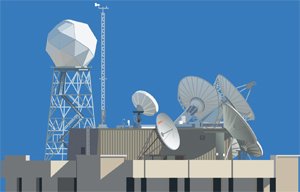 |
Director's NoteFred Best |
SSEC Mobile Atmospheric Measurement System
As many of you know, we are in the process of upgrading our mobile atmospheric measurement facility, originally known as the AERIbago. The AERIbago is a modified Winnebago motor home that was purchased under DOE funding in 1994 to house an SSEC-developed Atmospheric Emitted Radiance Interferometer and a radiosonde sounding system. Other instruments have been part of the measurement suite throughout the years, including a ceilometer, surface station, and GPS total precipitable water instrument.
The AERIbago has provided well-calibrated ground-based reference measurements for numerous field experiments through its lifetime. With its 20th birthday approaching, it is time to update this aging facility. This time around we are planning to house the instruments in a custom trailer that will be pulled by a heavy-duty pick-up truck. Decoupling the truck from the instrument area provides us more flexibility down the line. As before, the new facility will house an AERI and radiosonde system, but we will be adding a High Spectral Resolution Lidar (HSRL), developed by SSEC’s own lidar team, headed by Ed Eloranta. In addition, there will be growth potential to handle other instruments such as microwave radiometers and a precipitation radar.
The technical aspects of the new system are being led by Erik Olson. He is specifying the new trailer based on our needs in the field and he is ensuring that there is proper accommodation for each of the instruments (e.g. power, thermal, viewing, and etc.). Will Robus is managing the effort. He is responsible for coordinating the trailer procurement and the integration of all the add-ons once the trailer is delivered, including the thermal insulation, electrical system, hatch installations, build-out of the lab space, and finally the scientific instruments. Once the facility becomes ready for use, day-to-day operations will also be coordinated by Will.
Wayne Feltz is the Principal Investigator for the new facility. He will provide scientific leadership for the overall system and prioritize its use for field programs. If you are planning on using the new facility for a field program, even if it is tentative at this point, please notify Wayne. We hope to be operational sometime this summer.
The first order of business for the new facility is to find it a new name. It is now more than an AERI-centric system, and clearly it is no longer housed in a Winnebago – it will now be housed in a custom trailer, most likely from Stealth. So, we will have a contest to re-name the SSEC mobile atmospheric measurement facility. The contest will be announced in an email very soon, stay tuned.
Hawk Cam Update
Many of us were hoping to see the nesting hawks again this year, but after starting to spruce up the nest on 2/25 they don’t seem too interested in last year’s nest. Several significant snow falls kept the old nest full of snow for much of March. Last year our Hawk Cam confirmed three eggs on 3/26. Because it seems that this timing must be on a biological clock, I was thinking that the hawks may have settled down elsewhere this year. I asked John Blakeman who is a red tailed hawk expert consulting with the NYT and Cornell, among others, if we have likely passed our window of opportunity and he replied with the following:
In the meantime we have a spare web cam ready for deployment if the hawks do reappear.“Don't use previous egg-laying time frames to discern when such activities might commence this year. Red-tails can be highly variable in laying-times and nest-use periods -- by a month or so. And none of this seems to relate much to temperatures or precipitation.
Just watch; see if the hawk pair resumes nest activity in the next two or three weeks. If there is no activity or visits to the nest by the birds by mid-April, chances for re-use will be quite low. But don't be surprised if nest refurbishment -- the bringing in and placement of new sticks and bowl lining --- commences quickly in the next two weeks. The one prompting factor is increasing photoperiods, and we are gaining several minutes of daylight each day now, which turns on reproductive hormones, resulting in consequent activities.
So, again, just wait and watch. There is a very good chance that hoped-for nesting activities will promptly resume.
But on the other hand, Red-tails, too, are noted for abandoning recently used, otherwise fine nest sites, and putting up a new nest sometimes but a 100 meters away. Usually, new nests are somewhere within a quarter mile or so of the previous nest. The reasons and motivations for these new nests in new, nearby locations are a mystery.
So don't be surprised (but disappointed, of course) should the pair put a new nest elsewhere on the campus.”

